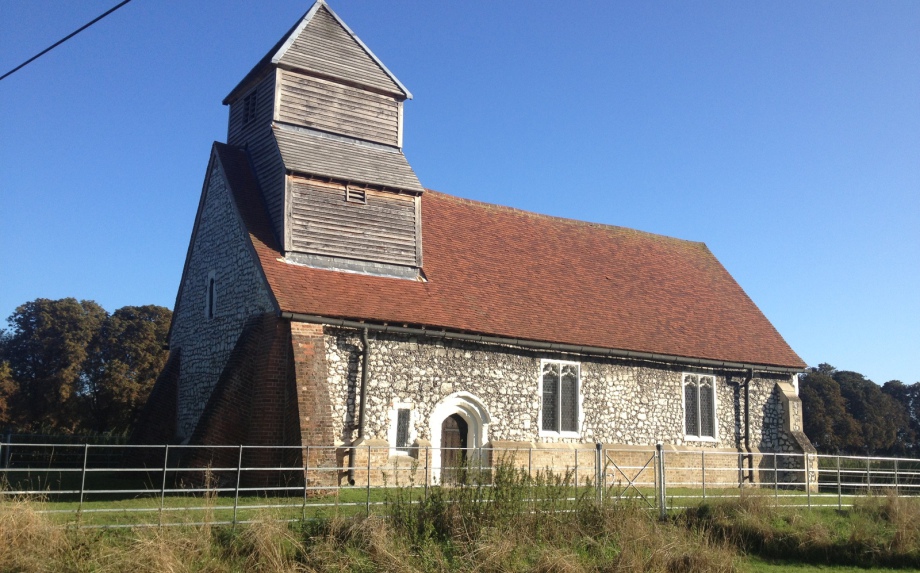
History of the Church
The chapel of St Mary Magdalene, Boveney stands on a site which has been a place of worship since before the Roman conquest.
Its origins are obscure but it is first mentioned in 1266, when the offerings there were assigned to the vicarage of Burnham. No further reference to it has been found until 1508, when Robert Aldridge of that parish left 3/4d to it by his Will.
It was dependant on the mother church at Burnham, and a bull of Pope Leo, dated 1513, ordered the Vicar of Burnham to find a Chaplain to 'celebrate Mass there as heretofore'.
In 1519 it was presented that the glass windows of the chancel were defective and the divine offices were not said at the appointed hours.
The Chapel was annexed to Burnham as a chapel of ease when the advowson of Burnham was given to Eton College. Lipscombe in his History of Bucks, Vol iii p214, says that William Glover was presented to the living of Burnham by John Hawtry in 1669 and, after his death in 1707 the presentation to the Vicarage of Burnham with Boveney Chapel has been on the nomination of Eton College)
An Act of Parliament in 1737 to make Boveney a separate living failed for want of sufficient endowment. The Vicar of Burnham and his curate held a service there on the first Sunday of each month, but in 1767 the chapelry demanded a service every Sunday and protested its independence except as regards burials.
It appointed its own churchwardens, looked after its own poor and repaired the highways.
By an order in Council dated 25th May 1911, Boveney Liberty was ecclesiastically annexed to Eton, to which the church of St Mary, Magdalene is now a chapel of ease.
The chapel originally served the village of Boveney and surrounding area which at that time was one of the largest villages in the area.
The Chapel was probably used by bargees and other riverside folk when there was a busy wharf nearby used for transporting timber from Windsor Forest.
The above information was extracted from the Victoria History of the Counties of England. (A history of Buckinghamshire Vol iii edited by William Page, FSA and published in London by the St Catherine’s Press 1925).
The church of ST. MARY MAGDALENE at Boveney is a rectangular building about 51 ft. by 19 ft. with no structural division between chancel and nave. Over the roof at the west end is a wooden bell-turret. The fabric of the church dates from the 12th century, but the details are later. The walls are of rubble with flint garreted joints and limestone dressings, and the roof is tiled. In the gable of the east wall there is a 16th-century window of two lights beneath a square head, and in the wall above can be seen indications of an earlier pointed window. The north doorway has a pointed head and jambs of two continuously chamfered orders and probably dates from the 15th century. The north wall has in addition two windows, the easternmost, a small square-headed light, of 13th-century date, and the other is a restored 15th-century window of two cinquefoiled lights with quatrefoils under a square head, to the east of which is a contemporary stone corbel carved with vine leaf ornament. In the south wall are two windows similar to the two-light window opposite, a 15th-century pointed doorway, and, near the west, a small rectangular light resembling that in the north wall. In the gable at the west end is a small single-light window, which probably dates from the 12th century. The bellturret is supported from the floor by a framework of timber, part of which is hidden by plaster. Four old tie-beams of the roof are exposed, but the remainder is concealed by a plaster ceiling. The font has a bowl shaped like a truncated cone, with an edge roll, and stands upon a base of two steps. It may date from the 13th century, but is thickly covered with whitewash. A low screen consisting of pieces of old carved oak divides the chancel from the nave; it has a post on either side of the central opening which is crowned with a 15th-century poppy head, and the cresting, which was added during the 19th century, is made up from the frieze of some 17th-century panelling. In the chancel and on the north and south walls of the nave is some 17th-century panelling, that on the north wall of the nave with a frieze being of the 17th century, and the pulpit is made up of panelling of the same period. The oak communion table may be of late 17th-century date. Some oak benches, probably of early 16th-century date, remain in the nave, a few of the standards of which have been renewed. There are three bells: the treble, 1631, and the second, 1636, are by Ellis Knight; the tenor is inscribed with the first seven letters of the alphabet in Gothic capitals, and probably dates from the middle of the 16th century.
The above was extracted from Parishes: Burnham with Lower Boveney, Pages 165-184, A History of the County of Buckingham: Volume 3. Originally published by Victoria County History, London, 1925.
Pages 165-184
. Originally published by Victoria County History, London, 1925.
